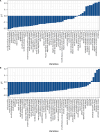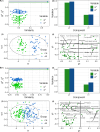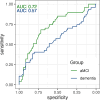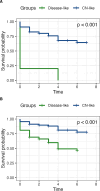Predicting progression from subjective cognitive decline to mild cognitive impairment or dementia based on brain atrophy patterns
- PMID: 38970077
- PMCID: PMC11225196
- DOI: 10.1186/s13195-024-01517-5
Predicting progression from subjective cognitive decline to mild cognitive impairment or dementia based on brain atrophy patterns
Abstract
Background: Alzheimer's disease (AD) is a progressive neurodegenerative disorder where pathophysiological changes begin decades before the onset of clinical symptoms. Analysis of brain atrophy patterns using structural MRI and multivariate data analysis are an effective tool in identifying patients with subjective cognitive decline (SCD) at higher risk of progression to AD dementia. Atrophy patterns obtained from models trained to classify advanced AD versus normal subjects, may not be optimal for subjects at an early stage, like SCD. In this study, we compared the accuracy of the SCD progression prediction using the 'severity index' generated using a standard classification model trained on patients with AD dementia versus a new model trained on β-amyloid (Aβ) positive patients with amnestic mild cognitive impairment (aMCI).
Methods: We used structural MRI data of 504 patients from the Swedish BioFINDER-1 study cohort (cognitively normal (CN), Aβ-negative = 220; SCD, Aβ positive and negative = 139; aMCI, Aβ-positive = 106; AD dementia = 39). We applied multivariate data analysis to create two predictive models trained to discriminate CN individuals from either individuals with Aβ positive aMCI or AD dementia. Models were applied to individuals with SCD to classify their atrophy patterns as either high-risk "disease-like" or low-risk "CN-like". Clinical trajectory and model accuracy were evaluated using 8 years of longitudinal data.
Results: In predicting progression from SCD to MCI or dementia, the standard, dementia-based model, reached 100% specificity but only 10.6% sensitivity, while the new, aMCI-based model, reached 72.3% sensitivity and 60.9% specificity. The aMCI-based model was superior in predicting progression from SCD to MCI or dementia, reaching a higher receiver operating characteristic area under curve (AUC = 0.72; P = 0.037) in comparison with the dementia-based model (AUC = 0.57).
Conclusion: When predicting conversion from SCD to MCI or dementia using structural MRI data, prediction models based on individuals with milder levels of atrophy (i.e. aMCI) may offer superior clinical value compared to standard dementia-based models.
Keywords: Alzheimer’s disease; Atrophy patterns; Multivariate analysis; Structural MRI; Subjective cognitive decline.
© 2024. The Author(s).
Conflict of interest statement
OL, DF, ES, DvW, PT, SP, NM-C, JH and EW report no competing interests. OH has acquired research support (for the institution) from ADx, AVID Radiopharmaceuticals, Biogen, Eli Lilly, Eisai, Fujirebio, GE Healthcare, Pfizer, and Roche. In the past 2 years, he has received consultancy/speaker fees from AC Immune, Amylyx, Alzpath, BioArctic, Biogen, Cerveau, Eisai, Eli Lilly, Fujirebio, Genentech, Merck, Novartis, Novo Nordisk, Roche, Sanofi and Siemens.
Figures





References
-
- Hansson O. Biomarkers for neurodegenerative diseases. Nature Medicine. 2021 27:6 [Internet]. 2021 [cited 2023 Feb 27];27:954–63. https://www.nature.com/articles/s41591-021-01382-x. - PubMed
-
- Mattsson-Carlgren N, Andersson E, Janelidze S, Ossenkoppele R, Insel P, Strandberg O et al. Aβ deposition is associated with increases in soluble and phosphorylated tau that precede a positive Tau PET in Alzheimer’s disease. Sci Adv [Internet]. 2020 [cited 2023 Mar 24];6. https://pubmed.ncbi.nlm.nih.gov/32426454/. - PMC - PubMed
-
- Aisen PS, Cummings J, Jack CR, Morris JC, Sperling R, Frölich L et al. On the path to 2025: Understanding the Alzheimer’s disease continuum. Alzheimers Res Ther [Internet]. 2017 [cited 2023 Mar 24];9:1–10. https://alzres.biomedcentral.com/articles/10.1186/s13195-017-0283-5. - PMC - PubMed
-
- Sperling RA, Jack CR, Aisen PS. Testing the right target and right drug at the right stage [Internet]. Sci Transl Med. Sci Transl Med; 2011 [cited 2020 Jul 14]. https://pubmed.ncbi.nlm.nih.gov/22133718/. - PMC - PubMed
-
- Cummings J, Feldman HH, Scheltens P. The rights of precision drug development for Alzheimer’s disease. Alzheimer’s Research & Therapy 2019 11:1 [Internet]. 2019 [cited 2023 Mar 22];11:1–14. https://alzres.biomedcentral.com/articles/10.1186/s13195-019-0529-5. - PMC - PubMed
Publication types
MeSH terms
LinkOut - more resources
Full Text Sources
Medical

